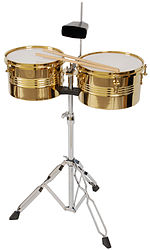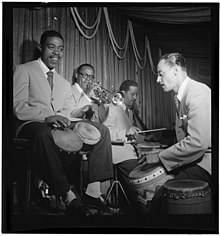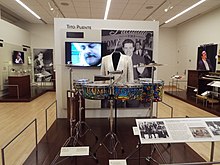Timbales
 Timbales with a single cowbell | |
| Percussion instrument | |
|---|---|
| Other names | Timbaleta, pailas, pailas criollas |
| Classification | drum |
| Hornbostel–Sachs classification | percussion (membranophone) |
| Developed | c. 1900 in Cuba |
| Related instruments | |
| Timpani, bongo drum | |
Timbales (/tɪmˈbɑːliːz/) or pailas are shallow single-headed drums with metal casing. They are shallower than single-headed tom-toms and usually tuned much higher, especially for their size.[1] They were developed as an alternative to classical timpani in Cuba in the early 20th century and later spread across Latin America and the United States.
Timbales are struck with wooden sticks on the heads and shells, although bare hands are sometimes used. The player (called a timbalero) uses a variety of stick strokes, rim shots, and rolls to produce a wide range of percussive expression during solos and at transitional sections of music, and usually plays the shells (or auxiliary percussion such as a
Timbales have average diameters of 33 cm (13 in) (macho drum) and 35 cm (14 in) (hembra drum).[2] Originally made of calfskin, the heads are most commonly made of plastic for increased volume and durability and mounted on a steel rim.[2] The shells are usually made of metal, although wooden shells are also available. In general, the drums are mounted on a stand and played while standing. Smaller timbales called timbalitos are often incorporated into larger drum kits.
Etymology
In Spain and in classical music contexts across the Hispanophone world, the word timbales (sing. timbal) refers to
In Cuba and Latin America, timbales (timpani) were adapted into pailas, which is the name given to various Spanish metallic bowls and pans used as cookware (see paila). Paila derives from Old French paele, from Latin patĕlla.[3] However, the term timbales continued to be used to refer to pailas, which is a less common term restricted to Cuba. Because of the historical overlap in the use of timpani and pailas (both called timbales) by danzón orchestras between 1900 and 1930, usage of the term in that period is ambiguous.
Similar ambiguities exist in other languages. For example, in French, timbales (pronounced [tɛ̃bal]) is also the word for timpani, thus the French refer to Cuban timbales as timbales latines. In Brazil, the term timbal refers to an unrelated drum, timbau.
History


Origins and popularization
Timpani were imported into Cuba in the 19th century and used by wind orchestras known as
Timbales became an integral part of a smaller type of orchestra that superseded the orquestas típicas in the early 20th century, the
In the United States
Ubaldo Nieto, timbalero in

Technique
Baqueteo
The basic timbales part for danzón is called the baqueteo. In the example below, the slashed noteheads indicate muted drum strokes, and the regular noteheads indicate open strokes. The danzón was the first written music to be based on the organizing principle of sub-Saharan African rhythm, known in Cuba as

Bell patterns
During the

In the 1970s José Luis Quintana "Changuito" developed the technique of simultaneously playing timbale and bongo bell parts when he held the timbales chair in the songo band Los Van Van. The example below shows the combined bell patterns (written in a 2–3 clave sequence).

Tito Puente was frequently seen in concerts, and on posters and album covers, with seven or eight timbales in one set. The timbales were occasionally expanded with drum kit pieces, such as a kick or snare drum. By the late 1970s this became the norm in the genre known as songo.[11] Changuito and others brought rumba and funk influences into timbales playing. In contemporary timba bands, drummers, such as Calixto Oviedo, often use a timbales/drum kit hybrid.[12]
Solos
Típico style
The original style of soloing on timbales is known as típico ('typical'). Manny Oquendo (1931–2009) played timbales solos famous for their tastefully sparse, straight forward típico phrasing. The following five measure excerpt is from a timbales solo by Oquendo on "Mambo."[13] The clave pattern is written above for reference. Notice how the passage begins and ends by coinciding with the strokes of clave.[14]
Rumba quinto rhythmic vocabulary
By the late 1940s and early 1950s, some timbaleros ('timbales players'), particularly
Derivative instruments
Timbalitos
Timbalitos or pailitas are small timbales with diameters of 15 centimetres (6 in), 20 centimetres (8 in) or 25 centimetres (10 in). The timbalitos are used to play the part of the
Mini timbales
Mini timbales small timbales, similar to timbalitos, often used by rock drummers as part of their drum kits. For examples, drummer
Marching Timbales
The Ohio University Marching 110 is the only collegiate marching band in the United States to march timbales in their percussion section. Timbales were added to the band in 1971, accompanying five snare drums, two bass drums, two tenor bass drums, and two sets of cymbals. The band does not use a normal set of multi tenor drums that most marching bands do, and instead use a combination of timbales and duo-tenor drums to fulfill the mid-ranges of the percussion section's sound. Together, the section is known as the "Middle Voices" or "Middles".
References
- ^ a b Orovio, Helio 1981. Diccionario de la música cubana: biográfico y técnico. Entries for Paila criolla; Timbal criollo.
- ^ ISBN 9780826463227.
- ^ Corominas, Joan (1981). Diccionario crítico etimológico castellano e hispánico. Madrid: Spain: Gredos. p. 339.
- Bloomington, IN: Authorhouse. p. 42.
- ^ Quintana, José Luis; Silverman, Chuck (1998). Changuito: A Master's Approach to Timbales. Belwin-Mills. p. 25.
- ISBN 9780932367150.
- ISBN 978-958-33-6805-9.
- ^ Silverman, Chuck; Mauleón, Rebeca; García, Richie (1994). "The Drummers of Cuba". Modern Drummer. 175: 30–33, 87–98.
- ISBN 978-1-135-72534-1.
- ISBN 1-886502-80-3.
- ^ "The Clave and the Backbeat". Timba.com. Retrieved 19 April 2021.
- ^ Oviedo, Calixto (2011). "Beyond Salsa Percussion." Timba.com. "Beyond Salsa Percussion". Archived from the original on 2012-01-13. Retrieved 2012-01-23.
- ^ "Mambo" Understanding Latin Rhythms (Patato, et al.) LP Ventures LPV-337-A (1974).
- ISBN 1-886502-80-3.
- ^ Anderson, B.K. "AFRO-CUBAN PERCUSSION, ITS ROOTS AND ROLE IN POPULAR CUBAN MUSIC" (PDF). KANSAS STATE UNIVERSITY. Retrieved September 3, 2020.
- ^ Velez, A.E. (13 April 2009). "Manny Oquendo, Latin Band Leader and Stylistic Innovator, Dies at 78". The New York Times. Retrieved September 23, 2018.
- ^ "Top 9 Timbales For Sale – 2018 Reviews". Instrument Insider. 4 March 2017. Retrieved October 28, 2018.
- ^ "Archived copy". Archived from the original on January 22, 2013. Retrieved February 28, 2012.
{{cite web}}: CS1 maint: archived copy as title (link) retrieved 28 February 2012 - ^ "MEINL PERCUSSION – the Ultimate Selection: Timbales". Archived from the original on 2012-07-11. Retrieved 2012-02-28. retrieved 29 February 2012
